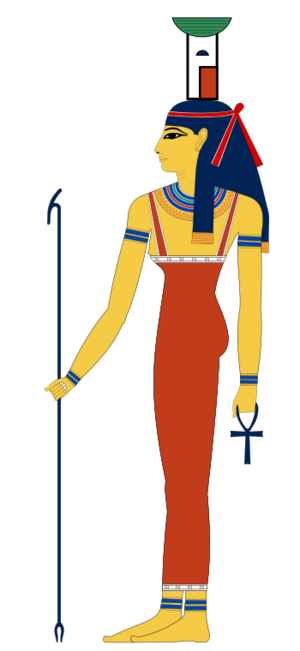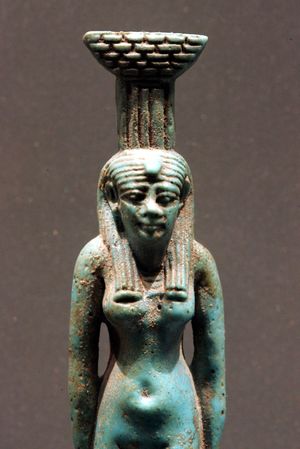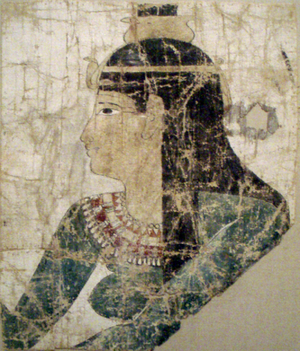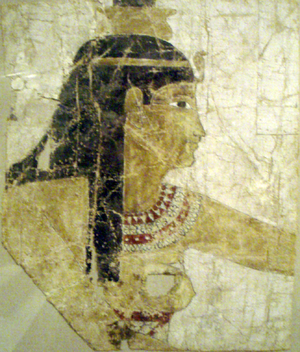نفتيس
| نفتيس | ||||
|---|---|---|---|---|
 صورت نفتيس عادة كامرأة شابة ، ترتدي غطاء الرأس على شكل منزل وسلة | ||||
| إلهة الرثاء | ||||
| الاسم بالهيروغليفية |
| |||
| مركز العبادة الرئيسي | لايوجد على وجه التحديد ، ديبوليس بارفا | |||
| الرمز | المنزل ، لفائف المومياء | |||
| الوالدان | جب و نوت | |||
| الأشقاء | إيزيس، أوزيريس، حورس، و ست | |||
| Consort | ست | |||
نفتيس Nephthys هي أحد الآلهة المصرية القديمة ، هي عضو في تاسوع هليوبوليس أخت كل من إيزيس أوزيريس, ست , وابنة كل من نوت إلهة السماء و جب اله الأرض. وطبقا للأساطير، فإنها كانت أما لأنوبيس، رب التحنيط، من أخيها أوزوريس.وفى رواية أخرى أم أنوبيس – سوبدو, رع.وتشتهر لدورها الهام في اسطورة الاوزيرية.[1]
مثلها مثل إيزيس تمثل الموت، الخفاء و الظلام . هي أيضا واحدة من الألهات الحاميات (إيزيس، نفتيس، سرقت، نيت ) للأواني الكانوبية التى تحتوى على أحشاء المتوفى . تظهر على شكل أنثى كاملة تعلو رأسها العلامة الدالة عليها .
. . . . . . . . . . . . . . . . . . . . . . . . . . . . . . . . . . . . . . . . . . . . . . . . . . . . . . . . . . . . . . . . . . . . . . . . . . . . . . . . . . . . . . . . . . . . . . . . . . . . . . . . . . . . . . . . . . . . . . . . . . . . . . . . . . . . . . . . . . . . . . . . . . . . . . . . . . . . . . . . . . . . . . . .
الاسم
باللغة المصرية القديمة نبت هوت وتعني ربةالقصر ، ألقابها : سيدة البيت ، ربة السماء سيدة الآلهة.
المهام
|
جزء من سلسلة مقالات عن |

|
|
المعتقدات الرئيسية
وثنية • وحدة الوجود • تعدد الآلهة |
| الشعائر |
| صيغة التقديم • الجنائز • المعابد |
| الآلهة |
| أمون • أمونت • أنوبيس • أنوكت أپپ • أپيس • آتن • أتوم باستت • بات • بس أبناء حورس الأربعة گب • هاپي • حتحور • حقت حورس • إيزيس • خپري • خنوم خونسو • كوك • معحص • ماعت معفدت • منحيت • مرت سگر مسخنت • مونتو • مين • مر-ور موت • نون • نيت • نخبت نفتيس • نوت • اوزيريس • پاخت پتاح • رع • رع-حوراختي • رشپ ساتيس • سخمت • سكر • سركت سوبك • سوپدو • ست • سشات • شو تاورت • تفنوت • تحوت واجت • واج-ور • وپواوت • وسرت |
| النـصـوص |
| عمدوعت • كتاب التنفس كتاب المغارات • كتاب الموتى كتاب الأرض • كتاب الأبواب كتاب العالم السفلي |
| غيرهم |
| الآتونية • لعنة الفراعنة |
ومهام نفتيس غير واضحة تماماً, ولا يعرف الكثير عن مركز ديانتها أو معبدها؛ رغم وجود أسماء معروفة لكهنة معابد نفتيس. وكانت نفتيس تعبد عادة مع رب آخر؛ مثل" ست" في عصر الدولة الحديثة, وأنتايوس في العصر المتأخر. وإلى جانب عدم وجود معلومات عن ديانة نفتيس؛ فإن اسمها الذي يعنى "سيدة البيت" لايعطي الكثير عن مهامها. وتظهر نفتيس عادة في صحبة شقيقتها إيزيس؛ لكنها تظل بغير هوية. ولعل ظهورها كان بسبب الحاجة المصرية إلى ضرورة تواجد الازدواجات؛ كما هو الحال مع ربات أخريات, مثل "تفنوت" وغيرها من الربات في مجمع أرباب هيرموبوليس. وكثيراً ما تظهر نفتيس مع إيزيس كندابتين بجوار المتوفى؛ أحيانا في صورة بشرية, أو كطائرين. وتصور الاثنتان معا كثيراً في مشهد وزن القلب في كتاب الموتى؛ كما أنها قامت بمهمة حماية أحد أبناء حورس الأربعة, وهو"حبي" المكلف بحفظ رئتي المتوفى. وفى العصر المتأخر ارتبطت نفتيس بالمعبودة "أنوقيت"(عنقت) وكانت تعبد معها في جنوب مصر.[2]
نفتيس وست
Though it commonly has been assumed that Nepthys was married to Set, recent Egyptological research has called this into question. Levai notes that while Plutarch’s De Iside et Osiride mentions the deity's marriage, there is very little specifically linking Nephthys and Set in the original early Egyptian sources. She argues that the later evidence suggests that:
while Nephthys’s marriage to Set was a part of Egyptian mythology, it was not a part of the myth of the murder and resurrection of Osiris. She was not paired with Set the villain, but with Set’s other aspect, the benevolent figure who was the killer of Apophis. This was the aspect of Set worshiped in the western oases during the Roman period, where he is depicted with Nephthys as co-ruler.[3]
الأخت المنقذة لأوزوريس
عندما حاول ست قتل أخيه أوزوريس، وقفت نفتيس إلى جانب إيزيس وأوزوريس ضده، وساعدت إيزيس في تحنيط جسد أوزوريس. ومنذ ذلك الحين، أعتبرت نفتيس وإيزيس، الربات الحاميات للمتوفى.[4]
New Kingdom cults of Nephthys
The Ramesside Pharaohs were particularly devoted to Set's prerogatives and, in the 19th Dynasty , a temple of Nephthys called the "House of Nephthys of Ramesses-Meriamun" was built or refurbished in the town of Sepermeru, midway between Oxyrhynchos and Herakleopolis, on the outskirts of the Fayyum and quite near to the modern site of Deshasheh. Here, as Papyrus Wilbour notes in its wealth of taxation records and land assessments, the temple of Nephthys was a specific foundation by Ramesses II, located in close proximity to (or within) the precinct of the enclosure of Set. To be certain, the House of Nephthys was one of fifty individual, land-owning temples delineated for this portion of the Middle Egyptian district in Papyrus Wilbour. The fields and other holdings belonging to Nephthys's temple were under the authority of two Nephthys-prophets (named Penpmer and Merybarse) and one (mentioned) wa'ab priest of the goddess.
While certainly affiliated with the "House of Set," the Nephthys temple at Sepermeru and its apportioned lands (several acres) clearly were under administration distinct from the Set institution.[5] The Nephthys temple was a unique establishment in its own right, an independent entity. According to Papyrus Wilbour,[6] another "House of Nephthys of Ramesses-Meriamun" seems to have existed to the north, in the town of Su, closer to the Fayyum region.
Another temple of Nephthys seems to have existed in the town of Punodjem. The Papyrus Bologna records a complaint lodged by a prophet of the temple of Set in that town regarding undue taxation in his regard. After making an introductory appeal to "Re-Horakhte, Set, and Nephthys" for the ultimate resolution of this issue by the royal Vizier, the prophet (named Pra'emhab) laments his workload. He notes his obvious administration of the "House of Set" and adds: "I am also responsible for the ship, and I am responsible likewise for the House of Nephthys, along with a heap of other temples."[7]
As "Nephthys of Ramesses-Meriamun," the goddess and her shrines were under the particular endorsement of Ramesses II. The foundations of the Set and Nephthys temples at Sepermeru finally were discovered and identified in the 1980s, and the Nephthys temple was a self-sustaining temple complex within the Set enclosure.[8]
There can be little doubt that a cult of Nephthys existed in the temple and great town of Herakleopolis, north of Sepermeru. A near life-sized statue of Nephthys (currently housed in the Louvre) boasts a curiously altered inscription. The basalt image originally was stationed at Medinet-Habu, as part of the cultic celebration of the Pharaonic "Sed-Festival," but was transferred at some point to Herakleopolis and the temple of Herishef. The cult-image's inscription originally pertained to "Nephthys, Foremost of the Sed [Festival] in the Booth of Annals" (at Medinet-Habu), but was re-inscribed or re-dedicated to "Nephthys, Foremost of the [Booths of] Herakleopolis." A "prophet of Nephthys" is indeed attested for the town of Herakleopolis in the 30th Dynasty.[9]
Chief goddess of Nome VII
Nephthys was considered the unique protectress of the Sacred Phoenix, or the Bennu Bird. This role may have stemmed from an early association in her native Heliopolis, which was renowned for its "House of the Bennu" temple. In this role, Nephthys was given the name "Nephthys-Kheresket," and a wealth of temple texts from Edfu, Dendara, Philae, Kom Ombo, El Qa'la, Esna, and others corroborate the late identification of Nephthys as the supreme goddess of Upper Egyptian Nome VII, where another shrine existed in honor of the Bennu. Nephthys also was the goddess of the "Mansion of the Sistrum" in Hwt-Sekhem (Gr. Diospolis Parva), the chief city of Nome VII. There, Nephthys was the primary protectress of the resident Osirian relic, of the Bennu Bird, and of the local Horus/Osiris manifestation, the god Neferhotep.[10]
Nephthys was most widely and usually worshipped in ancient Egypt as part of a consortium of temple deities. Therefore, it should not surprise us that her cult images could likely be found as part of the divine entourage in temples at Kharga, Kellis, Deir el-Hagar, Koptos, Dendereh, Philae, Sebennytos, Busiris, Shenhur, El Qa'la, Letopolis, Heliopolis, Abydos, Thebes, Dakleh Oasis, and indeed throughout Egypt.[11] In most cases, Nephthys found her typical place as part of a triad alongside Osiris and Isis, or Isis and Horus, or Isis and Min, or as part of a quartet of deities. It is perhaps, in this way that Nephthys best fulfilled her role as an important national deity whose ideal function was to provide powerful assistance to her associates in a great variety of temple cults—a truly "Useful" and "Excellent" goddess, as her primary epithets reflect.
. . . . . . . . . . . . . . . . . . . . . . . . . . . . . . . . . . . . . . . . . . . . . . . . . . . . . . . . . . . . . . . . . . . . . . . . . . . . . . . . . . . . . . . . . . . . . . . . . . . . . . . . . . . . . . . . . . . . . . . . . . . . . . . . . . . . . . . . . . . . . . . . . . . . . . . . . . . . . . . . . . . . . . . .
المصادر
- ^ نفيس
- ^ نفتيس
- ^ Levai, Jessica. "Nephthys and Seth: Anatomy of a Mythical Marriage", Paper presented at The 58th Annual Meeting of the American Research Center in Egypt, Wyndham Toledo Hotel, Toledo, Ohio, Apr 20, 2007.http://www.allacademic.com/meta/p176897_index.html
- ^ نفتيس
- ^ 'Land Tenure in the Ramesside Period' by S. Katary, 1989
- ^ Section 1. 28
- ^ Papyrus Bologna 1094, 5, 8-7, 1
- ^ 'Les Deesses de l'Egypte Pharaonique', R. LaChaud, 1992, Durocher-Champollion
- ^ Forgeau, 'Pretres Isiaques,' BIFAO 84, 155-157
- ^ خطأ استشهاد: وسم
<ref>غير صحيح؛ لا نص تم توفيره للمراجع المسماةReferenceB - ^ BIFAO website




